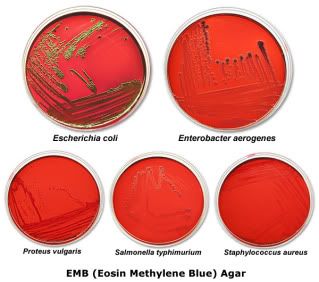|
| u Saturday, July 25, 2009 |
u Selective and Differential Media
Uses of selective & differential medium
The use of media that is both selective and differential not only selects for a particular group or species of organisms, it also reveals specific metabolic information that can point to a particular species. For example, MSA (Manitol Salt Agar) is selective for Gram positive organisms from the family Micrococcaceae and differential for Staphylococci. The Atlas describes the composition and characteristic results of various selective and differential media.
Selective Media
Culture medium that allows the growth of certain types of organisms, while inhibiting the growth of other organisms.
-dyes in the medium. For example, methylene blue in EMB & crystal violet in MacConkey's.
-high salt concentration in the medium. For example, 7% salt in MSA inhibit the growth of unwanted microorganisms.
Differential Medium
Culture medium that allows one to distinguish between or among different microorganisms based on a difference in colony appearance (color, shape, or growth pattern) on the medium.
-dyes in the medium. For example eosin/methylene blue in EMB.
-pH indicators change the color of the medium as sugars in the medium. For example, lactose in EMB & MacConkey's and mannitol in MSA are fermented to produce acid products.
EMB (Eosin Methylene Blue) Agar
-selective for: gram-negative bacteria
-differential for: lactose fermentation

MacConkey's Agar
-selective for: gram-negative bacteria
-differential for: lactose fermentation

MSA (Mannitol Salt Agar)
-selective for: gram-positive Staphylococci bacteria
-differential for: mannitol fermentation

Hemolysis with Blood Agar
-not selective
-differential for: hemolysis
- based on the ability to break down hemoglobin or red blood cells, 3 groups of microorganisms can be described
*alpha-hemolysis: bacteria partially break down hemoglobin leaving a green pigment around the colonies
* beta-hemolysis: a clearing is seen around the colonies as bacteria produce a "beta-hemolysin" which lyses the red blood cells
* gamma-hemolysis (no hemolysis): no hemolysis is observed, bacteria do not produce a hemolysin

[posted by chocobo237 at 12:02 AM][website] |
design by MK
|
|
|